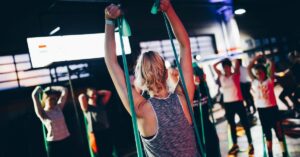Revolutionize Your Recovery: Insider Hacks for Enhanced Mobility and Injury Prevention

Introduction: The Unsung Hero of Athletic Performance
When we think of athletic prowess, images of sweat-slicked muscles, heart-pounding competition, and triumphant victories often dance in our minds. But what about recovery? It’s the quiet, often overlooked partner in the dance of athleticism. Recovery is not just a passive wait-and-recover scenario; it’s a proactive approach that can make or break an athlete’s performance. So, how can we revolutionize our recovery? Buckle up, because I’m about to share some insider hacks that can enhance your mobility and help prevent those pesky injuries that seem to strike at the most inconvenient times.
Understanding the Science of Recovery
Before diving into the hacks, let’s take a moment to understand what recovery really entails. Recovery is a complex interplay of physiological processes that allow the body to heal and grow stronger. Think of it as a fine-tuned orchestra, where each section—muscles, tendons, and joints—must play in harmony to create the beautiful symphony of athletic performance.
According to sports physiologists, the recovery phase involves several key components:
- Muscle Repair: Muscles experience micro-tears during intense physical activity. Recovery allows these tears to heal, leading to stronger muscle fibers.
- Glycogen Replenishment: After a workout, your body needs to replenish glycogen stores—think of glycogen as the fuel in your tank. Without it, your performance can suffer.
- Fluid Balance: Hydration plays a critical role in recovery. Dehydration can lead to muscle cramps and fatigue, which are not ideal for anyone who wants to crush their next workout.
- Psychological Recovery: Mental fatigue is just as real as physical fatigue. Recovery is a time to reset mentally, too.
Knowing this, it becomes clear that our recovery strategies need to be as comprehensive as our training regimens. Now, let’s get into some insider hacks that will help you maximize your recovery.
Hacks for Enhanced Mobility
1. Dynamic Stretching Before Workouts
A dynamic warm-up can be a game-changer. Forget static stretching before a workout—this is the kind of stuff that might have worked in gym class, but we’re aiming for high-performance here! Dynamic stretching involves controlled movements that improve range of motion and prepare your muscles for action.
For instance, consider incorporating exercises like leg swings, walking lunges, and arm circles. These not only enhance mobility but also increase blood flow to the muscles. As a former high school athlete (who occasionally skipped warm-ups, I admit), I can’t stress enough the difference it makes to enter a workout already warmed up and ready to go.
2. Foam Rolling: Your New Best Friend
If you’ve never tried foam rolling, it’s like giving your muscles a little love letter. Foam rolling, or self-myofascial release, helps to break down knots and improve blood flow. It’s not just about rolling around like a human log; it’s about targeting specific muscle groups that may be tight.
To get started, try rolling out your quads, hamstrings, and calves. I can still remember the first time I rolled out my IT band—let’s just say, it was a love-hate relationship. You might feel some discomfort (okay, a lot), but the relief afterward is worth it.
3. Incorporate Yoga or Pilates
These practices are often touted for their flexibility benefits, but they do so much more. Yoga and Pilates emphasize core strength, balance, and flexibility, all of which contribute to enhanced mobility. Plus, they’re fantastic for mental recovery—a little zen can go a long way after a tough training session.
Here’s a fun story: I once attended a yoga class designed specifically for athletes. I walked in thinking I’d breeze through it, only to be humbled by the instructor’s ability to twist into pretzel-like shapes. But I left that class with newfound respect for flexibility and a killer post-workout glow.
Injury Prevention: The Proactive Approach
1. Embrace Strength Training
It’s easy to fall into the trap of thinking that endurance is king. I know I did in my early days of training. But strength training is crucial for injury prevention. By building muscle around your joints, you create a supportive framework that can absorb impact and reduce the risk of injury.
Many athletes shy away from lifting heavy weights, fearing they’ll bulk up and lose speed. Instead, focus on functional strength training—think bodyweight exercises, resistance bands, and lighter weights with higher repetitions. Trust me, a strong core and stable joints can be your best allies.
2. Listen to Your Body
This one sounds simple, but it’s often ignored. How many times have you powered through a workout despite feeling a twinge? Guilty as charged! But learning to listen to your body can prevent a minor discomfort from turning into a major injury. If something doesn’t feel right, don’t push it. Take a break, modify your workout, or consult a professional.
Remember the old adage: “No pain, no gain” is not always true. Sometimes, no pain is the best gain!
3. Cross-Training: The Spice of Life
For those who are all about running, cycling, or swimming, it might be hard to think about stepping outside your comfort zone. But cross-training can be a game-changer for injury prevention. Alternating your workout routine not only prevents overuse injuries but also keeps things fresh and exciting.
Try mixing in activities like swimming, cycling, or even dance classes. (Yes, I know, dance! But hey, it’s all about fun, right?) I once took a Zumba class thinking it’d be a light workout. I left with sore muscles and a newfound respect for dancers everywhere.
The Role of Nutrition in Recovery
Let’s face it, you are what you eat. The fuel you provide your body directly impacts your recovery process. A good recovery diet focuses on several key elements:
- Protein: Essential for muscle repair. Aim for lean sources like chicken, fish, or plant-based proteins.
- Complex Carbohydrates: Fuel your body and replenish glycogen stores. Think brown rice, quinoa, and whole grains.
- Healthy Fats: These are crucial for hormone production and joint health. Incorporate avocados, nuts, and olive oil.
- Hydration: Water is your best friend! Aim to keep yourself hydrated, especially after workouts.
One of my fondest post-workout memories is sitting down with a protein shake and a hearty bowl of quinoa salad. It felt good knowing I was nourishing my body and aiding my recovery at the same time.
Sleep: The Unsung Hero of Recovery
Let’s not overlook the magic of a good night’s sleep. Sleep is when your body does most of its healing. Research suggests that quality sleep can boost performance, reduce injury risk, and improve mental health. So, how can you ensure you’re getting quality Zs?
- Establish a Routine: Go to bed and wake up at the same time every day—yes, even on weekends!
- Create a Sleep-Friendly Environment: Dark, quiet, and cool are the magic words.
- Limit Screen Time: The blue light from screens can interfere with your body’s natural sleep cycle.
Taking a step back, I remember a time when I was juggling multiple commitments—late nights became the norm. I quickly learned that sacrificing sleep was a surefire way to feel sluggish, cranky, and ultimately, sidelined by injury. Trust me, prioritizing sleep pays off!
Recovery Tools: Gear Up for Success
Now that we’ve explored some insider hacks, let’s talk about tools. Recovery gear has exploded in popularity, and for good reason. Here are some tools you might consider adding to your recovery arsenal:
- Compression Gear: These garments help improve blood circulation and reduce muscle soreness.
- Massage Guns: Perfect for targeting tight spots and promoting blood flow.
- Cold Therapy Packs: Great for reducing inflammation and speeding up recovery.
- Heat Wraps: Useful for relaxing muscles and improving blood flow.
And let’s not forget the classic ice bath—a rite of passage for many athletes. I can still feel the icy shock that sends your body into a state of shock! But, believe it or not, it actually works wonders for reducing inflammation.
Conclusion: A Holistic Approach to Recovery
Revolutionizing your recovery isn’t just about one hack or tool; it’s about embracing a holistic approach that considers all aspects of your lifestyle—from mobility exercises and injury prevention strategies to nutrition and sleep. Each piece of this puzzle contributes to a more robust, resilient athlete.
As I reflect on my own journey, it strikes me that recovery is not merely an afterthought; it’s an integral part of the athletic experience. So, the next time you lace up your sneakers, remember that recovery is not just about resting; it’s about actively preparing for your next triumph. By incorporating these insider hacks into your routine, you’ll not only enhance your mobility but also set yourself up for long-term success.
Embrace the process, listen to your body, and remember: recovery is where the magic happens.







